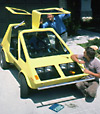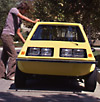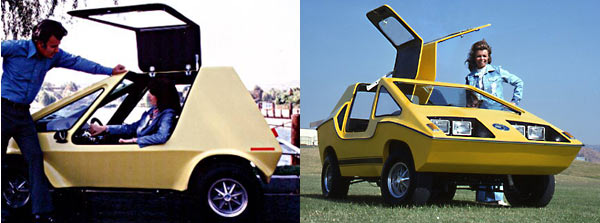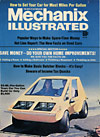|
|

UrbaCarAn Urban Runabout Powered by a 12 kW
(16 hp)
|
|||||||||||||
|
|
|
UrbaCar Original protype (L) and Pre-Production Prototype (R)
|
|
The original prototype, as it appear in Mechanix Illustrated, was powered by a 12 kW (16 hp) single cylinder industrial engine mounted in the rear. It delivered a top speed of 95 km/h (60 mph) and fuel economy on the order of 23 km/l (55 mpg). Using today's automotive technology, it could easily reach 100 mpg. The design featured removable gull-wing doors and a 10 gallon fuel tank that would hold enough fuel for nearly 965 km (600 mi). UrbaCar tips the scales at a mere 295 kg (650 lb). Because of its low curb weight, the small 12 kW (16 hp) engine still gives it a power-to-weight ratio about equal to that of the early VW Beetle. And more powerful engines can be installed. The simple drive train uses a continuously variable transmission (CVT), which transfers power to an oil-bath chain drive and then through a differential to the rear wheels. A standard automotive starter motor drives the car in reverse. The integral power train (engine, transmission, and final drive mounted on a sub-frame) is suspended from the rear of the chassis at four points using soft rubber mounts. This allows for easy removal of the drive package, and it effectively isolates vibrations. Ultimately, UrbaCar went through three generations of improvements.
The perfected version was slated for
production in Kitchener, Ontario, until public interest in high fuel
economy vanished as the oil market stabilized. Plans offered here include the
previously unpublished and vastly improved production chassis. UrbaCar's body is built of FRP/urethane foam composite. For more information on the body construction method, click on One-Off Construction Using FRP/Urethane Foam Composite. Click on the images to the left to view large images. Click here for more on the history of UrbaCar, published on the Forgotten Fiberglass website. Be sure to follow their link to a video of the pre-production prototype on the road in Canada (incorrectly labeled as the "first electric car"). About the Plans Plans are based on an upgraded chassis design and done in 2D CAD. These revised plans include improvements to the chassis and power train that were developed over three generations of prototypes. The frame and final drive package is the pre-production design that went to Kitchener, Ontario, in anticipation of production. The body is the original fiberglass-over-foam body on the vehicle that appeared in Mechanix Illustrated Magazine. Until this revised plan-set was published, the new chassis design was not available to the general public.
|
||||







